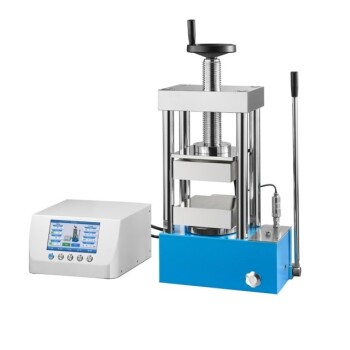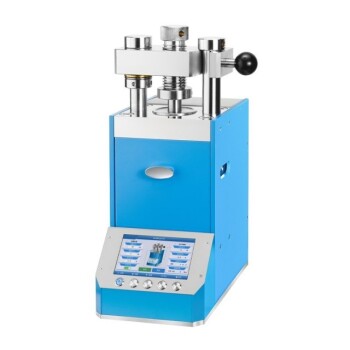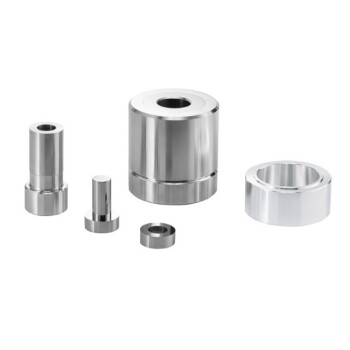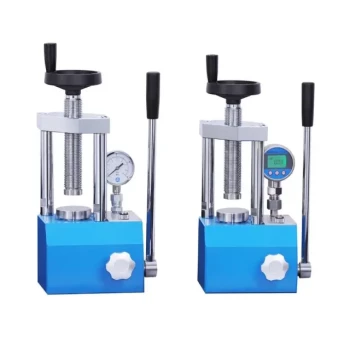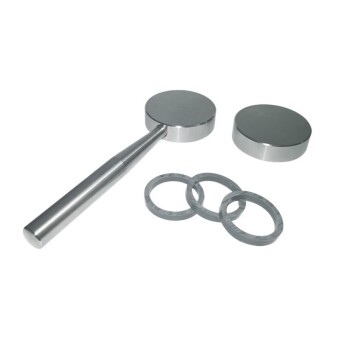When preparing sample pellets, the mandatory minimum safety equipment includes high-impact safety glasses and appropriate chemical-resistant gloves. This Personal Protective Equipment (PPE) is essential for safeguarding against both the chemical nature of the powdered sample and the significant physical forces exerted by the pellet press during operation.
Your primary goal is to mitigate two distinct categories of risk: chemical exposure from the sample material and catastrophic physical failure of the press or die set. Simply wearing the equipment is not enough; understanding why you are wearing it is the key to true laboratory safety.
Deconstructing the Risks: Why PPE is Non-Negotiable
Pellet preparation, while a routine analytical procedure, involves handling potentially hazardous materials and operating high-pressure machinery. Each piece of PPE is designed to counter a specific, critical risk.
Protecting Your Eyes from Physical Hazards
A laboratory pellet press generates immense force, often many tons, concentrated on a small steel die set. If a die is old, improperly assembled, or pushed beyond its pressure limit, it can fail catastrophically.
This failure can send sharp metal or hardened sample fragments flying at high velocity. High-impact safety glasses are the absolute minimum protection required to prevent severe eye injury in such an event.
Guarding Against Chemical Exposure
The powdered samples themselves present a chemical risk. Many materials are skin irritants, are toxic if absorbed, or can cause serious damage if they come into contact with your eyes.
Gloves provide a necessary barrier, preventing direct skin contact with the sample powder. Safety glasses, in turn, protect your eyes from any airborne dust generated during sample handling and loading.
Preventing Sample Contamination
Safety works both ways. The integrity of your analytical result depends on a pure, uncontaminated sample.
Oils, moisture, and trace contaminants from your hands can easily be transferred to the sample powder, compromising the accuracy of sensitive techniques like XRF or FTIR. Wearing gloves is as much about protecting the sample as it is about protecting yourself.
Common Safety Oversights and Best Practices
Going beyond the basics is crucial for establishing a robust safety protocol. Experienced operators are mindful of these additional layers of protection.
The Importance of the Press Safety Shield
Most hydraulic presses are equipped with a transparent, high-impact polycarbonate safety shield. This is not optional. This shield is your primary line of defense against a catastrophic die failure and should always be in place during pressing.
Beyond Glasses: The Role of a Face Shield
For operations involving particularly brittle materials or when pressing near the upper load limit of the die, a full-face shield worn over your safety glasses provides a superior level of protection. It shields your entire face, not just your eyes.
Choosing the Right Gloves
Not all gloves offer the same protection. While nitrile gloves are a good general-purpose choice for most powders, they may not be suitable for all chemicals, especially if you use a solvent during sample prep. Always verify that your glove material is resistant to the specific chemicals you are handling.
Respiratory Protection for Fine Powders
If your sample is a particularly fine powder or contains known respiratory hazards (such as silica or heavy metals), additional protection is required. Using a dust mask or an N95 respirator is critical to prevent inhalation. Whenever possible, fine powders should be handled in a fume hood.
Selecting the Right Level of Protection
Your choice of PPE should be directly informed by the specific materials and pressures you are working with.
- If your primary focus is routine analysis of non-hazardous materials: At a minimum, always wear safety glasses and nitrile gloves to protect against press failure and sample contamination.
- If you are working with toxic, irritating, or very fine powders: Add respiratory protection (like an N95 mask) and handle the material in a fume hood to prevent inhalation.
- If you are operating the press near its maximum load or with brittle dies: A full-face shield and the mandatory use of the press's built-in safety guard are critical for preventing serious injury.
Proactively assessing the risks of your specific task is the foundation of safe and effective scientific work.
Summary Table:
| Risk Type | Recommended Safety Equipment | Key Purpose |
|---|---|---|
| Physical Hazards | High-impact safety glasses, Face shield, Press safety shield | Protect eyes and face from flying debris during press operation |
| Chemical Exposure | Chemical-resistant gloves (e.g., nitrile) | Prevent skin contact and sample contamination |
| Inhalation Risks | Dust mask or N95 respirator | Guard against fine powder inhalation in fume hoods |
Ensure your lab's safety and efficiency with KINTEK's reliable lab press machines, including automatic, isostatic, and heated models. Our equipment is designed to meet rigorous safety standards, reducing risks during pellet preparation. Contact us today to learn how we can support your laboratory needs and enhance your workflow!
Visual Guide
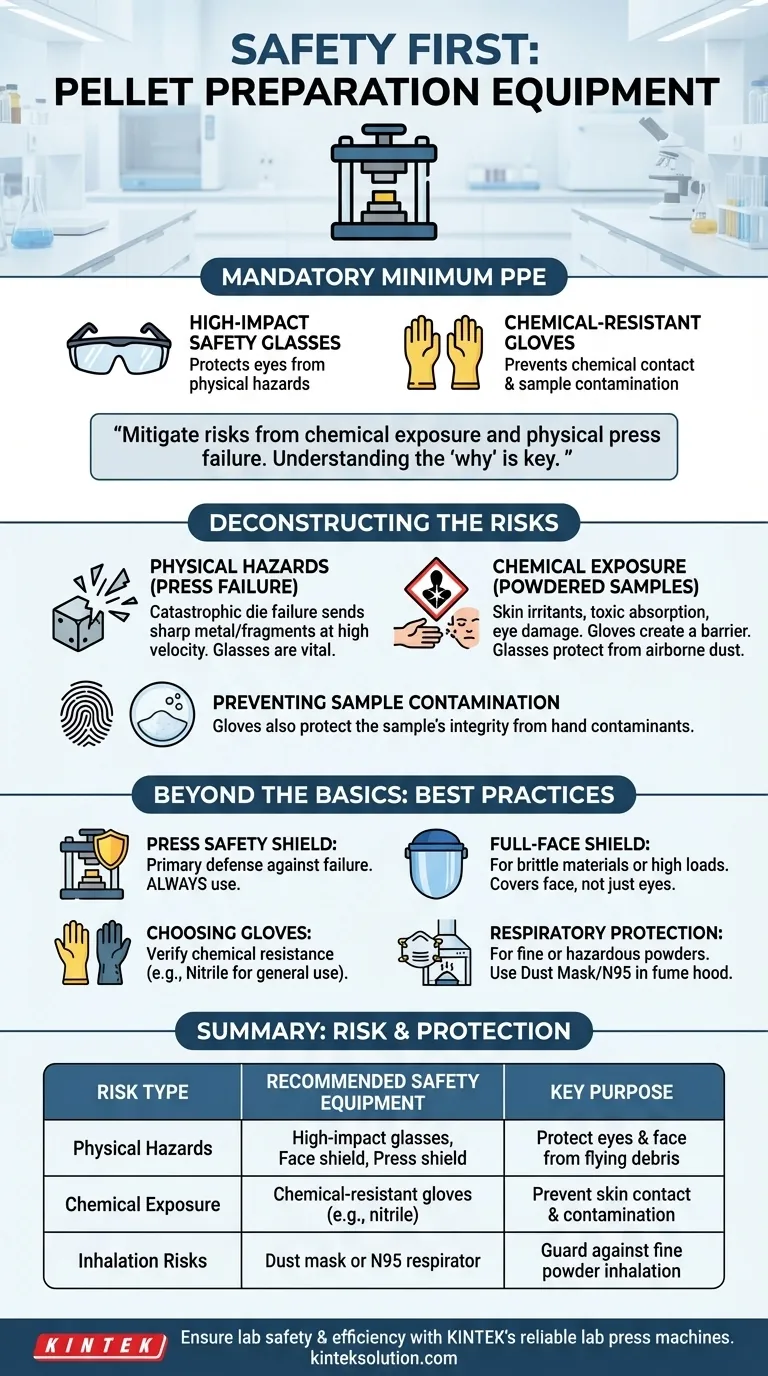
Related Products
- Laboratory Hydraulic Press Lab Pellet Press Button Battery Press
- Laboratory Hydraulic Split Electric Lab Pellet Press
- Automatic Laboratory Hydraulic Press Lab Pellet Press Machine
- Laboratory Hydraulic Pellet Press for XRF KBR FTIR Lab Press
- Manual Heated Hydraulic Lab Press with Integrated Hot Plates Hydraulic Press Machine
People Also Ask
- How are hydraulic presses used in spectroscopy and compositional determination? Enhance Accuracy in FTIR and XRF Analysis
- How are geological samples prepared for XRF analysis? Ensure Accurate Results with Proper Pellet Prep
- What are the durability and efficiency benefits of hydraulic pellet presses? Boost Lab Productivity with Reliable Performance
- How do hydraulic pellet presses contribute to material testing and research? Unlock Precision in Sample Prep and Simulation
- How does a hydraulic mini press compare to a hand press for sample preparation? Achieve Consistent, High-Quality Results





